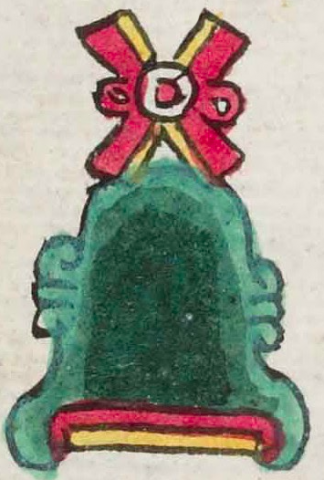Olintepec (Mdz24v)
This compound glyph for the place name Olintepec has two notable features. One is the calendrical symbol for movement or earthquakes (olin). It is a large X with small concentric circles at the heart of the cross, yellow on the outside and red in the center, and two additional concentric circles on either side of the cross, yellow on the outside and red in the center. The inner part of the X is painted yellow, and the outer part is red. Below the symbol for movement/earthquake is a classic hill or mountain (tepetl), with its two-tone bell shape, red and yellow stripes near the base, and its curling, rocky outcroppings on the slopes. The locative suffix (-c) (as given in the gloss) is not shown visually, but it combines with -tepe- to form -tepec, a visual locative suffix meaning "on the hill" or "on the mountain."
Stephanie Wood
The outside hoops on the X shape are reminiscent of the hoops on a ball court, possibly placed on there intentionally to recall the ball game, given that the homophone olli means rubber and rubber ball. The shape of this glyph has the effect of a four-part quatrefoil with a center for a vertical axis that would connect the four cardinal points with the heavens and the underworld, creating a quincunx. This sign is slightly reminiscent of tonatiuh and xihuitl. Olin is the seventeenth of the twenty signs days of the tonalpohualli calendar, so they all share a temporal meaning. The center of this quincunx may substitute for a "starry eye," which is what we see in another glyph for olin. The starry eye is reminiscent of representations of nighttime, yohualli, and connecting movement to the cosmos and the movement of planets. While we concur with John Sullivan's emphasis on the distinction between olin (movement) and olli (rubber), balls that bounced in a way symbolic of the sun's movement through the ball courts (tlachtli), as explained in The Mesoamerican Ballgame website of the Metropolitan Museum of Art. Other studies of the ball game refer to the sun and the moon or planets, such as a publication of the Maya Archaeologist.
See another representation of olin from the Codex Borbonicus, with the added value of the number four, referring to the date Nahui Olin. This glyph from the Codex Mendoza is quite different from the olin glyph in the Codex Magliabecchiano, which has an added point at the top (in yellow, green, and red) and a shape at the bottom (in green, red, and white) something like the quincunx on the tonatiuh glyph. The x-shape of the Magliabecchiano olin is green on the left and yellow on the right, with an internal red line. The concentric circles on right and left have red centers. The eye at the center is outlined half green and half yellow, with a red lid, white pupil, and white eyeball.
The olin is a day name in the 260-day divinatory calendar (the tonalpohualli), and children were named Olin who were born on this day. Calendrics played an important role in Nahuas' religious views of the cosmos.
Stephanie Wood
Olintepec.puo
Olintepec, pueblo
Stephanie Wood
c. 1541, but by 1553 at the latest
movement, calendar, movimiento, hule, pelotas, calendarios, días, fechas, earthquakes, temblores, terremotos, nombres de lugares

ol(in), movement, earthquake, https://nahuatl.wired-humanities.org/content/olin
tepe(tl), hill or mountain, https://nahuatl.wired-humanities.org/content/tepetl
-tepec, on the hill or mountain, https://nahuatl.wired-humanities.org/content/tepec
"On the Hill of the Earthquake" (agreeing with Berdan and Anawalt) [Frances Karttunen, unpublished manuscript, used here with her permission.]
"On the Hill of the Earthquake" (Berdan and Anawalt, 1992, vol. 1, 196)
"En el Cerro (o Montaña) del Movimiento (o Temblor)"
Codex Mendoza, folio 24 verso, https://digital.bodleian.ox.ac.uk/objects/2fea788e-2aa2-4f08-b6d9-648c00..., image 59 of 188.
The Bodleian Libraries, University of Oxford, hold the original manuscript, the MS. Arch. Selden. A. 1. This image is published here under the UK Creative Commons, “Attribution-NonCommercial-ShareAlike 3.0 License” (CC-BY-NC-SA 3.0).






